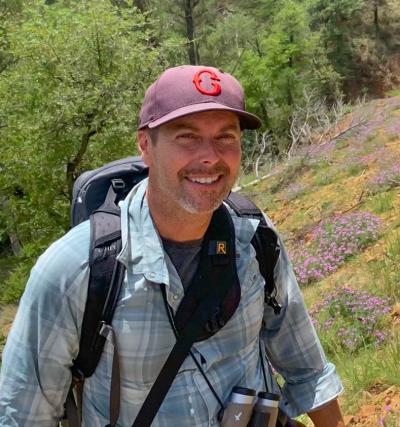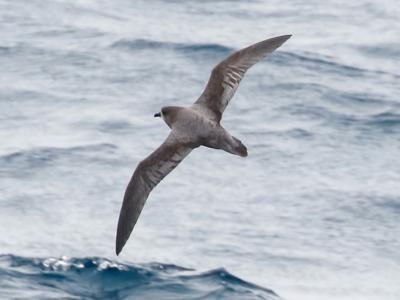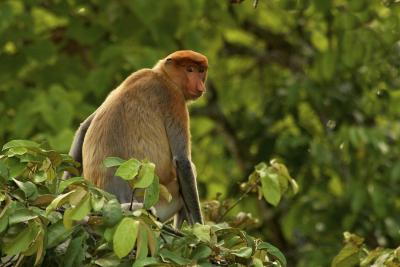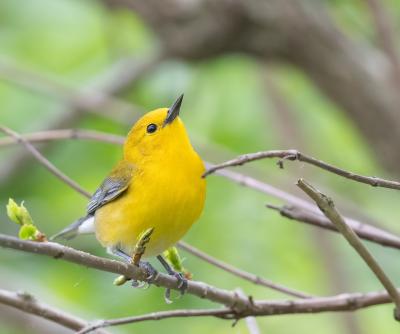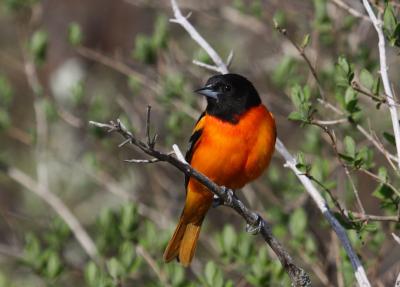Texas: The Edwards Plateau and Big Bend
The oaks and limestone hills of the Edwards Plateau form a cool, green boundary between east and westTexas. Here amid a profusion of spring wildflowers and a varied array of eastern and western birds, we’ll look especially for the region’s two special summer residents, Golden-cheeked Warbler and Black-capped Vireo. After a day and a bit on the Edwards Plateau we’ll travel west to Big Bend National Park, where tall mountains rise out of the arid west Texas plains. In this scenic region birds from Mexico and the Rocky Mountains converge and include some highly sought-after species such as Lucifer Hummingbird, Gray Vireo, and Colima Warbler.
Day 1: The trip begins by 5:00 p.m. at the San Antonio International Airport. Night in Kerrville.
Day 2: This morning we will look for satisfying views of Black-capped Vireo or Golden-cheeked Warbler (Black-capped Vireo is possible at Big Bend National Park as well.) Alternatively, we’ll visit Park Chalk Bluff near Uvalde, where we might see either Green or Ringed Kingfisher. Some south Texas species such as White-tipped Dove, Couch’s Kingbird, and Olive Sparrow reach the northern limit of their range about here, and the birding overall is excellent. During recent springs a Rufous-capped Warbler bred here, and if one is present we’ll likely search for it, unless we are still missing Golden-cheeked Warbler. Black-bellied Whistling Ducks are numerous in Uvalde, and Chimney Swifts breed here. In 2017 we found Northern Bobwhites along a lightly traveled road near Uvdale. Night in Uvalde.
Day 3: We may have a second chance to look for those two most celebrated plateau summer residents, Black-capped Vireo and Golden-cheeked Warbler. The region provides many delightful east-west contrasts: for example, we can stand along a cypress-fringed stream and listen to Eastern Wood Pewee, Great Crested Flycatcher, Carolina Wren, Yellow-throated Vireo, Yellow-throated Warbler, Field Sparrow, and Indigo Bunting, their voices mingling with those of Ash-throated and Brown-crested Flycatchers, Woodhouse’s Scrub-Jay, Canyon Wren, and Rufous-crowned Sparrow filtering down from the adjacent dry hillsides and rocky outcroppings. Migrants such as Orange-crowned and Nashville Warblers and Clay-colored Sparrow can be fairly common. We also have a chance of seeing Louisiana Waterthrush. TheTexas hill country seems anything but Texan in its cool lushness, and some of the areas we’ll visit, such as Lost Maples State Park, are very beautiful. Late in the day we’ll have a picnic dinner at a roadside table in Concan. Nearby is the Frio Bat Cave, where we’ll witness the mind-boggling exodus at dusk of literally over a million Mexican Free-tailed Bats. Cave Swallows, Black-throated Sparrows, and maybe Black-tailed Gnatcatchers and Scott’s Orioles will be present too, and as darkness settles we may well hear Common Poorwill and Chuck-will’s-widow if the night is calm and warm. Night in Uvalde.
Day 4: We’ll begin the long drive to the Chisos Mountains. Perhaps the most notable feature of the day will be the dramatic change to the arid landscapes of west Texas. En route we’ll stop to admire any Crested Caracaras, Harris’s Hawks, or Lark Buntings we come across, and we’ll scan through the ever-present Turkey Vultures for Zone-tailed Hawk. North of Brackettville is a site that sometimes has Gray Vireo and in 2017 we had a pair of Least Grebes at a pond near the ranch entrance where they filmed the first movie with John Wayne about the events of the Alamo in the late winter of 1836. We’ll stop briefly at Langtry, the location of Judge Roy Bean’s tavern, where he dispensed frontier justice near the turn of the last century. Here we usually see Cactus Wren and the very localized and intensely orange nominate race of Hooded Oriole. Night in Big Bend National Park.
Days 5–7: Bordering the sculpted canyons of the Rio Grande, the Chisos Mountains rise out of Big Bend National Park in a broken mass of colored sandstone reaching to almost 8000 feet. The range supports a variety of interesting birds including Lucifer and Blue-throated Hummingbirds, Gray Vireo, Varied Bunting, and Black-chinned Sparrow, but Colima Warbler is the major attraction since it can be seen nowhere else in the United States. We must make a long climb to find the warbler, but the scenery is dramatic and our pace will be slow, punctuated by Acorn Woodpeckers and parties of Mexican Jays and perhaps a few migrants. Sometimes a territorial Painted Redstart or two is present. All of one day will be devoted to this objective.
Big Bend provides delightfully varied birdwatching, and in addition to the mountains and high desert we’ll visit the Rio Grande floodplain, where cottonwoods and giant mesquites attract an entirely different set of birds. Vermilion Flycatcher,Bell’s Vireo, Summer Tanager, and Painted Bunting are common, and a pair of Common Black-Hawks and pair of Gray Hawks have nested in recent years. Other scarce species we may encounter include Cordilleran Flycatcher, Tropical Kingbird, Crissal Thrasher, and Lucy’s Warbler. In some years Black-capped Vireos are present in the Chisos Basin and very occasionally in Blue Creek Canyon too and they are usually easier to see here than in the more densely wooded hill country. At this season there may be a fine collection of migrants, perhaps including something quite unexpected. In the past we have encountered Tropical Parula and Flame-colored Tanager, and there are a handful of Slate-throated Redstart records from near Boot Spring. On at least one evening we’ll search for Lesser Nighthawk and Elf Owl, both fairly common. Nights inBig BendNational Park.
Day 8: After a final morning in Big Bend we’ll drive to Fort Davis, Texas, arriving in the mid-afternoon with time to do a little birding in Davis Mountains State Park. Migrants can be numerous at times in the flowering oaks, and there is at least a chance for Virginia’s Warbler. Breeders like Cassin’s Kingbird and Black-headed Grosbeak are common, and if we’re very lucky we may see Montezuma Quail. Night in Fort Davis,Texas.
Day 9: We’ll spend the morning in a reserve owned by the Nature Conservancy on the north side of Mt. Livermore, at over 8300 feet the highest mountain in the Davis Mountains. Here we should find new species, including Gray Flycatcher, Western Bluebird, Grace’s Warbler, and Hepatic Tanager. Steller’s Jay and Mountain Chickadee are possible too, as is Montezuma Quail. Much of the habitat was burned over in 2012, but as in many fire-prone areas, the habitat is recovering. We’ll plan to stop at Lake Balmorhea, a magnet for waterbirds in this parched land. Western and Clark’s Grebes are likely to be present, along with a number of shorebirds, and rarities in the past have included Pacific Loon and Reddish Egret. Small to moderate sized flocks of Franklin’s Gulls sometimes drop in, too. Late in the afternoon we’ll drive east to Fort Stockton. Night in Fort Stockton.
Day 10: We’ll leave quite early this morning for the 300-mile drive to San Antonio and stop along the way at Fort Lancaster if we are still missing Gray or Black-capped Vireo, both of which often nest near here. Varied Buntings are often present here, too, at about the east end of their range. We’ll plan to arrive at the San Antonio airport just past noon.
Note: The information presented below has been extracted from our formal General Information for this tour. It covers topics we feel potential registrants may wish to consider before booking space. The complete General Information for this tour will be sent to all tour registrants and of course supplemental information, if needed, is available from the WINGS office.
ENTERING THE UNITED STATES: Non-U.S. citizens will need a valid passport and may need a tourist visa. Consult your nearest U.S. Embassy or consulate for details.
Canadian citizens should carry proof of citizenship in the form of a passport or birth certificate. Please note that non-US citizens are required by law to carry passports/visas with them at all times. We suggest you carry these documents with you in your day-pack or some place that is easily accessible (not locked in your luggage). Because of proximity to the US-Mexico border, US Border Patrol checkpoints will be encountered on the roads and foreign nationals will be required to produce passports.
Resident non U.S. Citizens are required by law to have and show a green card at these check points; a failure to do so could result in a significant delay.
PACE OF THE TOUR: With the exception of the Boot Spring and Blue Creek Canyon hikes, we do not schedule anything even faintly strenuous at these altitudes. This tour does have several days with long drives and there are evening activities on a few of the days, making these days longer and most likely not concluding until later in the evening.
The hike to Boot Spring (in Big Bend National Park) for the Colima Warbler is lengthy (about 9.5 miles round trip) and steep (about a 2000’ climb) but the trail is excellent and we’ll allow plenty of time and go slowly. It may be possible to see the Colima Warbler without making the whole hike to Boot Spring. Participants with heart, back, hip, knee or ankle problems may elect to take a much shorter hike or to spend the day around the lodge; choosing the shorter option (or electing to take your own hike) may mean having to return to the lodge without the leader.
The Blue Creek hike for Lucifer Hummingbird, Gray Vireo and Varied Bunting is 4.6 miles round trip at an elevation of 4000 ft. It’s mostly level but some of it is on soft sand.
In the Davis Mountains where we also schedule some hiking, the longest walk will be about two miles round trip.
HEALTH: Texas presents no real hazards to the visiting birdwatcher.
Spiny Plants: The most common tour injuries result from spines penetrating the soles of running shoes. Many desert plants are armed with thorns or spines and we recommend leather or sturdy canvas boots of at least ankle height as the best safeguard.
Altitude: Much of our birding in west Texas is above 4000 feet. We reach 6500 feet on our climb for the Colima Warbler. Anyone with a circulatory or respiratory problem should consult their doctor.
Sun and Dehydration: April sun can be intense. A broad-brimmed hat, proper clothing and strong sun screen lotion are essential. It’s a good idea to have a water bottle with you at all times.
Insects: Texas does have mosquitoes and ticks, though there are fewer mosquitoes in central and west Texas.
Fire ants are widely distributed (sparse in West and Central Texas) and thoroughly noxious. The leaders will identify the ants at first encounter and remind you frequently to watch where you stand.
Smoking: Smoking is prohibited in the vehicles or when the group is gathered for meals, checklists, etc. If you are sharing a room with a nonsmoker, please do not smoke in the room. If you smoke in the field, do so well away and downwind from the group. If any location where the group is gathered has a stricter policy than the WINGS policy, that stricter policy will prevail.
Miscellaneous: We actively look for rattlesnakes and feel very lucky to see one per trip. These fascinating reptiles are generally not a hazard but one always needs to use common sense when dealing with potentially dangerous wild creatures. Scorpions are mostly nocturnal and rarely seen, and the tarantulas occasionally seen on the highway are not dangerous.
CLIMATE: Late April and early May temperatures can range from the low 30s - 40s F at night in the Davis Mountains to over 100° F in the lower elevations at Big Bend National Park. Rain is possible in the Hill Country but is unlikely at Big Bend.
ACCOMMODATIONS: We will be staying in comfortable motels and lodges. Our motels and lodges have WiFi.
FOOD: Most tour meals will be taken in area restaurants (one or two fast-food lunches), with field picnic lunches on most days. At Big Bend and in the Davis Mountains, we have picnic breakfasts in our rooms as the dining room at the Lodge doesn’t open until 7 AM. All meals are included in the tour price and, no refunds can be issued for any missed tour meals.
Food Allergies / Requirements: We cannot guarantee that all food allergies can be accommodated at every destination. Participants with significant food allergies or special dietary requirements should bring appropriate foods with them for those times when their needs cannot be met. Announced meal times are always approximate depending on how the day unfolds. Participants who need to eat according to a fixed schedule should bring supplemental food. Please contact the WINGS office if you have any questions.
TRANSPORTATION: We will be traveling by 12 or 15 passenger window van or minivan, depending on the group size. Participants should be able and willing to ride in any seat in tour vehicles.
2017 Narrative
Tour Summary
On this year’s Edward’s Plateau and Big Bend tour we found most of the hoped for species, starting with Black-capped Vireo and Golden-cheeked Warbler in the Texas Hill Country. At Big Bend we had excellent views of Lucifer Hummingbird and Colima Warbler. Other highlights included close views of a pair of Common Black-Hawks, Gray (nesting) and Zone-tailed Hawks, Painted Redstart, Varied Buntings, and a surprisingly cooperative pair of Crissal Thrashers. A pair of Least Grebes on a pond north of Brackettville was a surprise. The exodus of some one million Mexican Free-tailed Bats from Frio Bat Cave near Concan will not soon be forgotten.
Our tour began with a late afternoon pick-up at the airport in San Antonio followed by an hour and a half drive to Kerrville. We compared Turkey and Black Vultures overhead on the drive and after checking in had a Mexican dinner nearby.
The next morning we left early after breakfast for Kerr Wildlife Management Area. Our main goal was Black-capped Vireo which breeds here. The woodland here is more open than elsewhere, which means a better chance of seeing a bird. We found one singing pretty quickly, but still it took several hours for all of us to get decent views. Other birds of note included Eastern Phoebe, White-eyed Vireo, Blue-gray Gnatcatcher and Field Sparrow. Next we continued south arriving at Lost Maples State Park in time a picnic lunch. Along the way we noted several Scissor-tailed Flycatchers and stopped along the river and in the cypresses found a Yellow-throated Warbler, a breeder along the rivers in the Hill Country. Before hiking to the ponds we checked the feeders and noted a White-tipped Dove. This is north of their usual resident range, but the species has been pushing gradually northwards in recent years. The hike to the ponds was a bit slow bird-wise but upon arrival we were rewarded with fine views of a male Golden-cheeked Warbler, an endangered Texas endemic breeding species. They winter in the mountains of Middle America from Chiapas to at least Honduras. We had dinner at Neal’s at Concan and continued on to Uvalde for the evening.
The next morning we started at a park in Uvalde where we had nice views of a calling Couch’s Kingbird and a Brown-crested Flycatcher. Carolina Wrens were also present and many Black-bellied Whistling-Ducks were flying about and sitting in the trees. Next, we investigated county route 400 which followed the Leona River. This was a short dead end road which meant that traffic was sparse and the birding was excellent. Painted Buntings were numerous and we also had excellent views of several Northern Bobwhites, a rapidly declining species in North America. Wild Turkeys were also present along with Inca and Common Ground-Doves, nesting Cave Swallows, singing Painted Buntings and several Bullock’s Orioles. Several Bell’s Vireos were also present (the eastern subspecies bellii which is the most yellow and olive subspecies). We learned that they flick their tail up like most Empidonax flycatchers, unlike the two western subspecies (arizonae and pusillus) which wave their tail around like a Bewick’s Wren. The slightly duller subspecies to the west (medius) that we saw in western Texas at Big Bend is genetically like the eastern birds. The two groups may well represent separate species. Just to the north of route 400 we had good views of an adult male Scott’s Oriole and pairs of Curve-billed Thrashers and Hooded Orioles (sennetti subspecies) along with several Harris’s Hawks and Dickcissels. North of Concan we noted a male Eastern Bluebird and had distant views of a soaring Red-shouldered Hawk, our only one on the trip. Continuing back to Lost Maples State Park we again got to see the White-tipped Dove and this time heard it calling too (like blowing on a bottle). At the feeders, amongst the many Black-chinned Hummingbirds we found a single adult male Ruby-throated Hummingbird, a scarce migrant here. Carolina Chickadees and Black-crested Titmice were present. A one year old male Lazuli Bunting was our only one on the trip. On our return hike to the ponds we again had fine views of Golden-cheeked Warbler. An Acadian Flycatcher and a Black-and-white Warbler were also noted. In the early evening near dusk we watched some one million Mexican Free-tailed Bats fly out of the Frio Bat Cave.
The next day was a driving day to Big Bend National Park with few birding stops. We did bird the road north of Brackettville hoping for Gray Vireo. No sign of that species, but we did see our only Long-billed Thrasher of the trip and had fine views of a soaring Zone-tailed Hawk. At a small pond near the ranch where they filmed the battle of the Alamo with John Wayne, we noted a pair of Least Grebes, somewhat north of their mapped range. After lunch we stopped at the Judge Roy Bean’s visitor center where we noted a pair of the nominate subspecies (cucullatus) subspecies of Hooded Oriole. Later near Marathon we visited a Black-tailed Prairie Dog colony and nearby noted a large flock of some 100 Lark Buntings. On the drive south into the park we noted numerous Scaled Quail scurrying off the roadside.
Our full three days in Big Bend were divided between three distinct birding areas. On the first day we stopped first at Sam Nail Ranch where we had fine views of Yellow-breasted Chat and Summer Tanager. Of particular note was the pair of Crissal Thrashers which were surprisingly cooperative remaining for leisurely scope views. Next we hiked up Blue Creek Canyon in search of Lucifer Hummingbirds. Along the way we noted Bell’s Vireos, Pyrrhuloxias, Varied Buntings, Rock and Canyon Wrens, Black-tailed Gnatcatchers, Rufous-crowned Sparrows, and a single out-of-place female Lark Bunting. A singing Gray Vireo remained uncooperative and was only heard. After just over two miles we found a nice adult male Lucifer Hummingbird at the “usual” place and had extended scope studies as it continually returned to its perch, at one point interacting with a rival male. Numerous Greater Earless Lizards were about on the return along with a single cooperative “Big Bend” Tree Lizard. Thanks Jim for getting diagnostic photos. Later at lunch at Cottonwood Campground along the Rio Grande we studied Vermilion Flycatchers and a nest of Gray Hawk (brief views of one of the adults).
The next day was the long hike to Boot Spring and we left before dawn. Along the way groups of cooperative Mexican Jays (the bluer couchii Texas subspecies) joined us and looked for hand-outs. Hutton’s Vireos and Blue-gray Gnatcatchers were also present. Nearing Boot Spring we heard and some glimpsed a Colima Warbler, but it wasn’t until we reached the canyon that we finally got good views of one singing bird, Big Bend’s most famous summer resident and the only location in the United States where one can see this species. Other birds present included several Blue-throated Hummingbirds, a gorgeous singing Painted Redstart and two migrant Townsend’s Warblers. On the way down we encountered numerous California Sisters (often now split as its own species, the Arizona Sister) and had several White-throated Swifts.
On our final full day we headed east to Rio Grande Village. Here we had superb views of a pair of nesting Common Black Hawks and also had views of a perched and soaring Zone-tailed Hawk for comparison. Painted Buntings were numerous and we had a scattering of migrants including two Western Tanagers and a MacGillivray’s Warbler. Two “Mexican Ducks” a distinct subspecies (for now, perhaps will be restored to full species status eventually) of the Mallard were seen. Also of note were a Brown-crested Flycatcher and a single kingbird which was either a Couch’s or Tropical. Both are possible here and without hearing the calls the identification to subspecies is problematical. A party of Collared Peccaries was about too. Late in the day a Blue-throated Hummingbird was seen around the lodge. Near dusk we went to a place called K-Bar where several Lesser Nighthawks were seen and then finally two Elf Owls appeared and sat on the telephone lines. On several of the evenings a Gray Fox was seen around the lodge.
The next day was a travel day to the Davis Mountains, but we stopped first at Cottonwood Campground to look for Lucy’s Warbler. Sadly none were seen, but a single bird was heard singing. We did see a number of migrants heading up-river. These consisted of “Audubon’s” Yellow-rumped Warblers (some 75), and Wilson’s Warblers (at least a dozen). A single Gray Flycatcher and a Plumbeous Vireo were also noted and a few of us had a flock of Willets drop out of the sky to the Rio Grande. A family group of Black-tailed Gnatcatchers were also present. On the way north we noted several Chihuahuan Ravens and had great views of a pair of Burrowing Owls along the side of the road. Three Pronghorn were also seen. That evening Mark Lockwood joined us for a walk at Davis Mountains State Park (a male Hepatic Tanager and a Pine Siskin were the highlights). Sadly, no sign of Montezuma Quail.
The following morning under cold conditions we got up early and drove to the Nature Conservancy area on the north side of Mt. Livermore. Adjacent to the entrance we noted a group of displaying male Turkeys at Laurence E. Wood picnic area. Mark and our Nature Conservancy escort joined us for the excursion into the Nature Conservancy area. He knows the area well and we saw a number of interesting species including Broad-tailed Hummingbird, Western Wood Pewee, Gray Flycatcher, Woodhouse’s Scrub-Jay (woodhouseii subspecies), Violet-green Swallow, White-breasted Nuthatch (from the Rocky Mountain/Great Basin group of subspecies) Western Bluebird, Grace’s Warbler, Plumbeous Vireo, Bushtit, and Hepatic Tanager. Migrants included an Olive-sided Flycatcher, a Townsend’s Warbler and a MacGillivray’s Warbler. After lunch with Mark we said our good-byes and headed east for Lake Balmorhea. Here Field Guides a few days earlier had photographed an Aplomado Falcon, but sadly it wasn’t seen again. The cold rain and wind arrived and although birding was difficult we did have superb comparisons of various swallow species, including numerous Banks. We watched a large flock of Franklin’s Gulls drop out of the sky. Other species of note included a single immature Herring Gull (first cycle) and both Clark’s and Western Grebes along with a variety of ducks. We also had good comparisons of Least and Western Sandpipers. Just to the east we had nice studies of a single Clay-colored Sparrow.
Our final day was a drive day, but we stopped at the Fort Lancaster Overlook for a bit where most saw Gray Vireo well. An adult male Varied Bunting was very cooperative. Just to the east we found more Lark Buntings and had our best views of Blue Grosbeak, an adult male. We arrived at the San Antonio airport about noon where the tour concluded.
- Jon Dunn, 2017
This tour is limited to seven participants with one leader.












